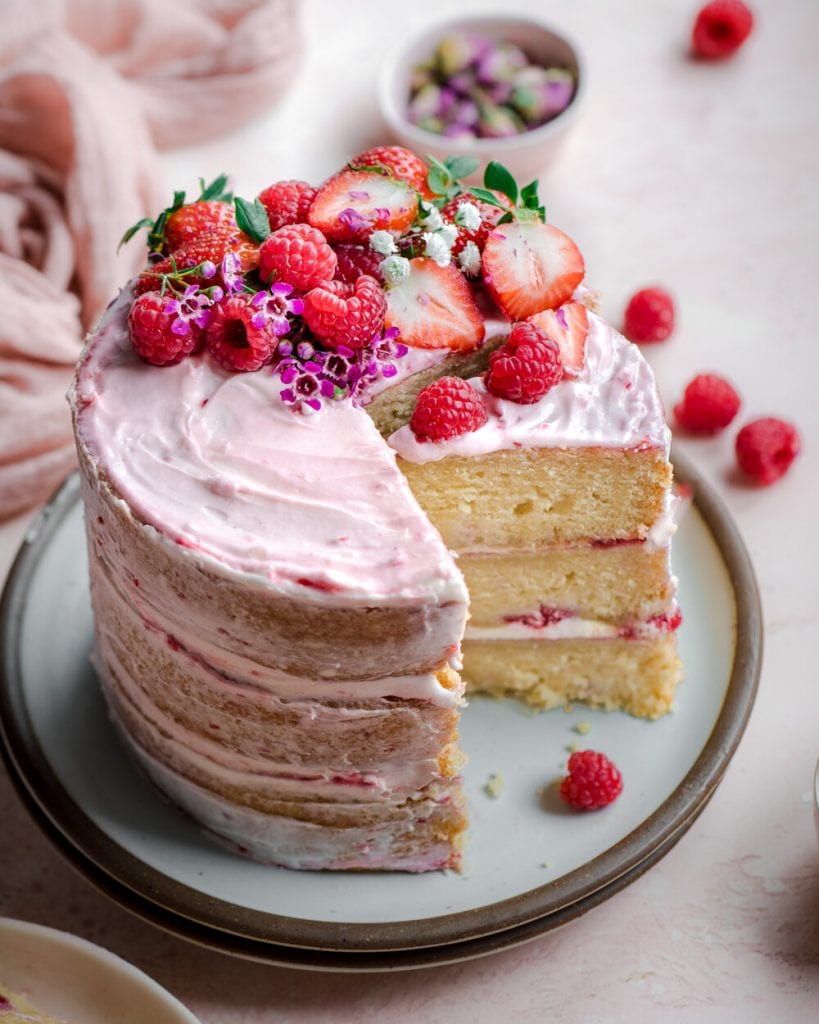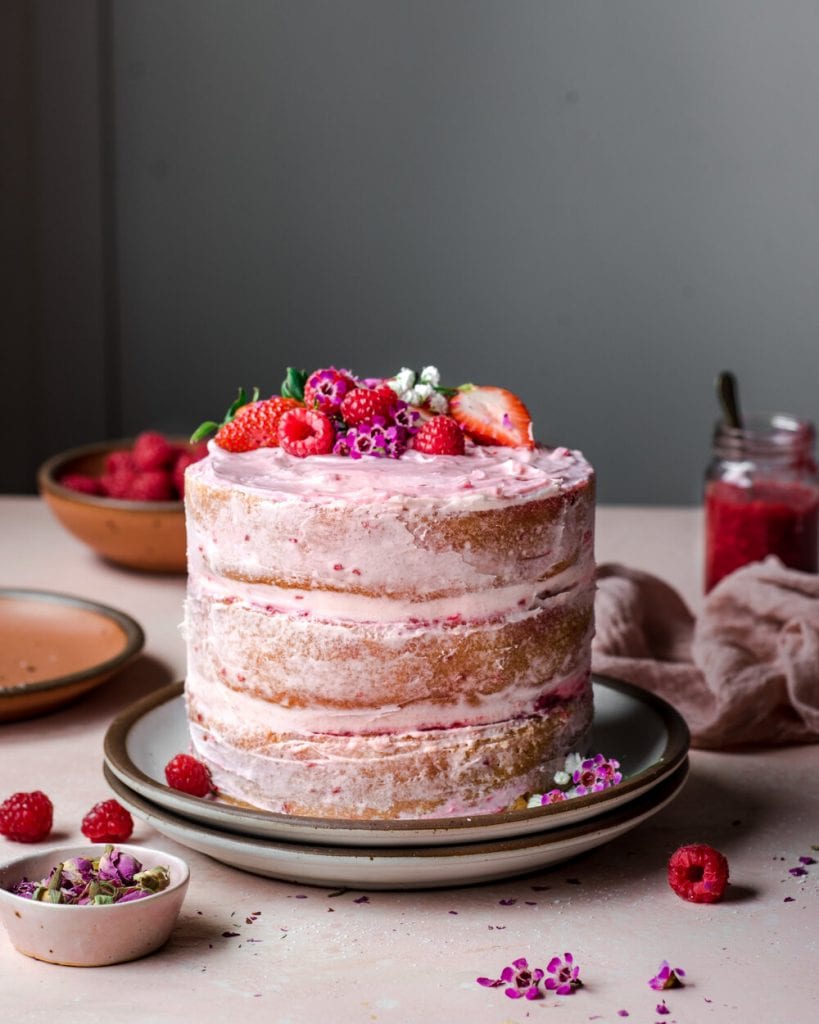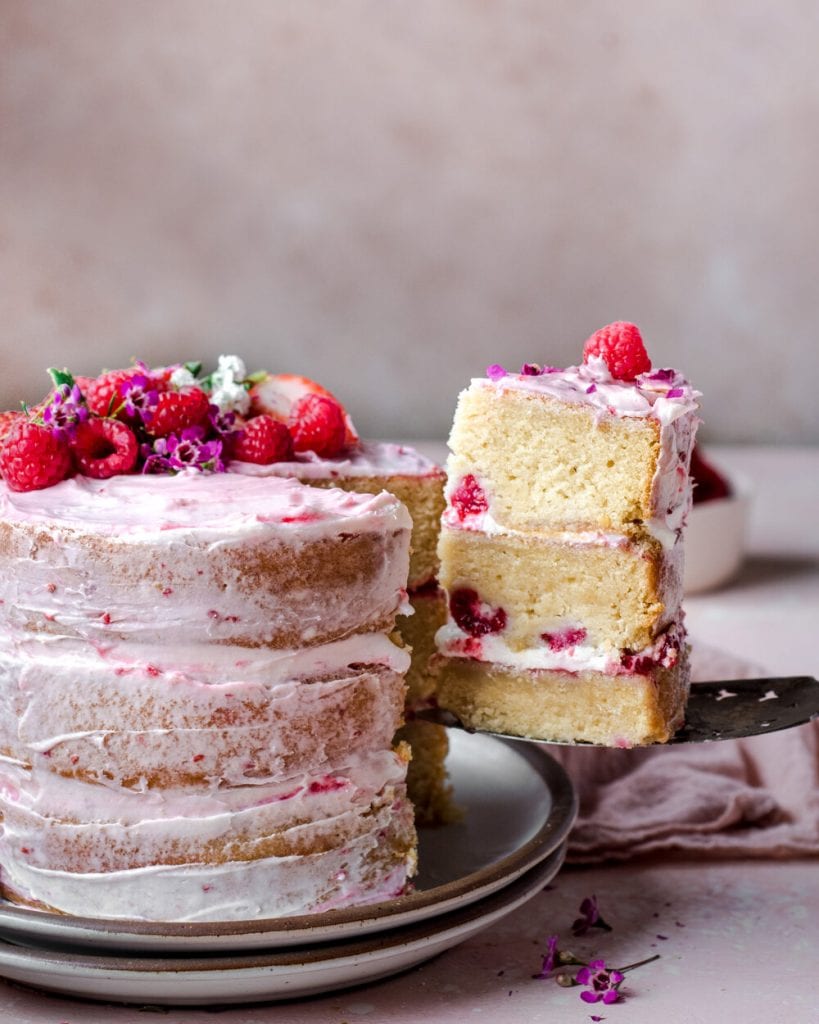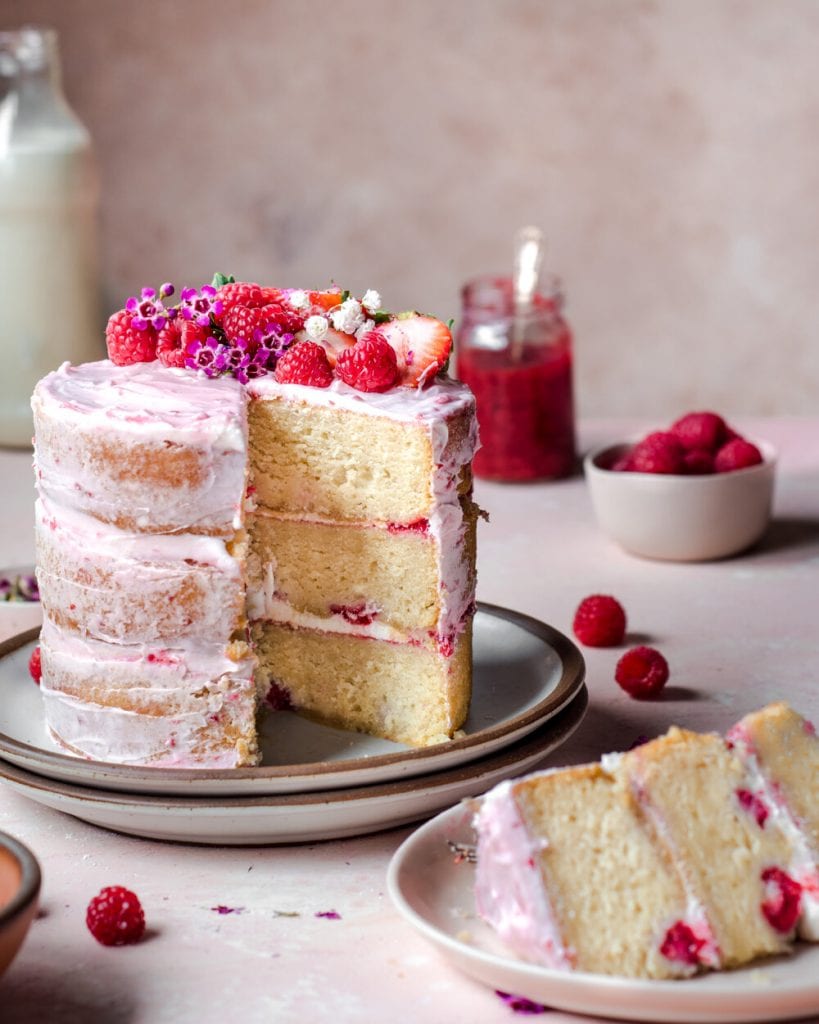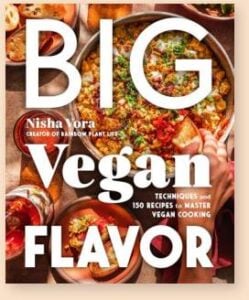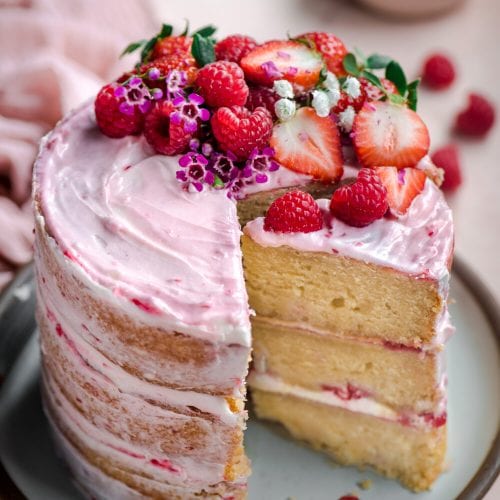This is one of my new favorite cakes, and I am not exaggerating. The texture is moist and tender (and I didn’t even use cake flour!), the flavors are sweet yet tart and tangy so it’s not overpoweringly sweet like some cakes, and of course, it’s so pretty! It might seem intimidating to assemble this kind of vegan layer cake, but once you’ve done it a few times, it’s actually pretty straightforward. In the event you’ve never made a layer cake, the blog contains detailed instructions and tips to help walk you through the process!
How to Bake a Vegan Layer Cake
Equipment needed for baking a vegan layer cake
Cake pans. You’ll need three 6-inch cake pans, or two 8-inch cake pans to bake this particular cake. Parchment Paper. You’ll need some parchment paper to line the bottom of each cake pan. This ensures you can easily invert your cakes without any of the cake sticking to the pan. Not essential but highly recommended; if you don’t use parchment paper, be sure to grease the bottoms of your cake pan really well. I use the bottom of one of the cake pans to trace a circle and then cut it out. Digital Scale. I recommend every home baker gets a digital kitchen scale for the most precise and consistent results. Since everyone has a different set of measuring cups and there are different methods of measuring ingredients like flour and sugar, a digital kitchen scale is super helpful for baking. This is especially the cake with layer cakes, where you are dividing the batter between different pans. Without a scale, you run the risk of one of the layers being much taller than the others, baking unevenly, etc. Oven Thermometer. Similar to a digital scale, an oven thermometer is another basic essential for any home baker. This is because every oven is different and many home ovens are not calibrated. This means that while your oven temperature might say 450°F, the actual oven temperature might be anywhere between 350°F and 500°F. The first time I made this cake, it didn’t bake through because my oven temperature was off. The digital display on my oven said 350°F but it was actually off by over 50°F! It was a bit under 300°F when i later checked with an external oven thermometer. An oven thermometer is especially helpful when baking a layer cake because—depending on the size of your oven and the size of your cake pans—you might need to bake them on separate oven rack layers, and most ovens vary in temperature between top racks, middle racks, and lower racks. Offset Spatula. This isn’t essential for baking cakes, but it is essential for beautifully frosted cakes. If you don’t care too much about the appearance of the cake, a butter knife will do. But, if you want beautiful frosting waves or want to achieve the “naked cake” look as seen in this recipe, an offset spatula is necessary. It helps smooth and level the tops of the frosting. When I’m making a smaller cake (as in these 6-inch cakes), I find it more helpful to use a small-sized offset spatula like this. Bench Scraper. Again, not a necessity, but it is very useful if you want to achieve the “naked cake” look in this recipe. A bench scraper perfectly smooths out the surface of the frosting, including the edges, and ensures that the frosting is evenly distributed (in a thin layer, in the case of a “naked cake”). If you don’t have a bench scraper, a small or medium straight spatula can also work.
Ingredients in a Vegan Layer Cake
Flour
The type of flour matters. This isn’t a gluten-free cake and I’m not going to pretend I’m an expert on gluten-free cakes, but generally speaking, cakes made with gluten-containing flour are going to be lighter and less dense in texture than than gluten-free cakes. If you have a gluten allergy, of course, I am not encouraging you to go ahead and test it. But if you can tolerate gluten, use the gluten-containing flour! I promise your taste buds will thank you. That said, if you are allergic or intolerant to gluten and want to make this cake, a 1:1 gluten-free all purpose baking flour is your best bet. I typically love making cakes with cake flour, as it yields the lightest texture, but I ran out of cake flour and was surprised how perfectly tender this cake came out using all-purpose flour.
Butter vs. Oil
The butter vs. oil debate is a something all bakers face, not just vegan bakers! Oil usually results in more tender baked goods, while butter is more flavorful than oil. Using an equal mix of oil and vegan butte lends a texture that is light and tender, but also incredibly rich, flavorful, and buttery. So you get the best of both worlds, texture wise. And it’s 100% vegan! I’ve had good success with Country Crock Plant Butter and Earth Balance buttery sticks.
Leaveners
The most commonly used leaveners in vegan baking are baking soda and baking powder, but this cake relies on a third leavener, commonly used in vegan cakes: vegan “buttermilk.” I simply combine plant-based milk with lemon juice and let it rest until it curdles. If you don’t have fresh lemon juice, you can use apple cider vinegar. As for baking soda and baking powder, this recipe uses a bit of both, and here’s why. When you use baking soda, it requires a little acid to start reacting. In this case, the acid is the vegan buttermilk (plant milk + lemon juice). It helps activate the leavening action of baking soda, enhancing the amount of rise in your cakes. And finally, the alkaline nature of baking soda (as opposed to the acidic nature of lemon juice) cancels out any sour buttermilk flavor so you don’t end up with an unwanted tangy taste. But if you want to keep some of that tang flavor (in a subtle way, of course), you’ll want to include some baking powder as well. This is a fruity cake with notes of raspberry and orange, so a subtle tangy flavor is desired. And since using baking soda alone will completely neutralize the vegan buttermilk’s acidity/tanginess, adding baking powder allows some of that tang to remain in the batter.
Egg Substitutes
The type of vegan egg substitute you use should depend on the type of baked good you’re making and your desired texture. For instance, I like to use flax eggs in brownies because it contributes to their fudgy gooeyness. But with a cake, I want the texture to be airy and light, so I like to rely on aquafaba, which is simply the liquid leftover from cooked chickpeas. When you lightly whip aquafaba, as is done in this recipe, it turns foamy and light, which then helps to create a light and fluffy texture and gives a nice lift to cakes. This recipe calls for 1/2 cup of aquafaba, and a standard 15.5 ounce can of chickpeas has a little more than 1/2 cup.
Components in this layer cake
Cake. This recipe uses three 6-inch layer cakes, but you could also make two 8-inch layer cakes. Frosting. A layer cake needs some sort of frosting or icing, and the Tangy Buttercream Frosting in this recipe is my new favorite frosting recipe. Essentially, it’s a hybrid of a buttercream frosting and a cream cheese frosting, and uses equal parts vegan butter and vegan cream cheese. I love the subtle but noticeable tanginess that the cream cheese and lemon juice bring to this cake. Unlike many cakes, the flavor does not have a one-note sweetness. If you can’t find vegan cream cheese, substitute the vegan cream cheese with more vegan butter and make a traditional buttercream frosting. Jam. The homemade Raspberry Jam in this recipe is optional and you can easily make this vegan vanilla layer cake without it. However, it serves three purposes. First, the jam is a tart, not-very-sweet jam, so again, it’s bringing a nice tart flavor that balances the sweetness of the cake. Two, the jam adds to the cake’s layered elements, making it more interesting texturally and visually. And three, when the jam gets swirled into the frosting, it makes for a beautifully pink cake, as seen in these photos.
How to assemble a layer cake
Refrigerate the cakes
Many bakers will recommend that you refrigerate your layer cakes before frosting, and I find this advice to be especially helpful with vegan cakes, which tend to be a bit stickier and/or delicate than non-vegan cakes. Adding frosting to a freshly baked cake—which is tender and delicate in texture, even if it has cooled to room temperature—creates friction, making it more likely that the cake will crumble. This isn’t the end of the world, but you will have considerable crumbs in your frosting and it won’t be as pretty. That’s why I recommend refrigerating your cooled cakes for at least 2 hours, or overnight, before frosting. Wrap them in plastic wrap to keep them moist. But if you’re avoiding plastic (a noble cause), you can put them on plates and cover them with large bowls. While refrigerating your cakes does add time onto this recipe, it also means that you can bake the cakes in advance. Cakes wrapped in plastic will stay good in your fridge for a few days, so you can do most of the work ahead of time. Or, if you want to make them even further in advance, you can easily wrap the cakes and freeze them.
Refrigerate the frosting
If you are making the Raspberry Jam in this recipe, I recommend refrigerating the frosting for about 30 minutes. If you add a layer of jam to the cake and then dollop room temperature frosting on top, it will be quite difficult to spread the frosting out, as the frosting will want to stay in place. It is not impossible to frost room temperature frosting, but it’s much easier if you refrigerate it for a bit. So, if you wanted to serve this cake at, say 7 pm, the ideal time to start prepping the frosting would be 5:30 pm. First, take the vegan butter and vegan cream cheese out of the fridge to soften. This should take around 30 minutes, depending on the temperature of your kitchen. To speed the softening process up, cut both components into small pieces. Second, make the actual frosting. It takes just 5-10 minutes. Third, refrigerate the frosting for 30 minutes before assembling the cake. If you make the frosting well ahead of time, you’ll want to refrigerate it anyways since it’s made with perishable items (vegan butter and cream cheese).
Assemble the “Naked “Cake”
Once your layer cakes have been cooled and your frosting and jam are ready, it’s time to actually assemble the cake! As you’ll see in these photos, I decided to go the naked cake route. A naked cake has a minimal outer layer of frosting, which shows off the cake’s layers and filling. But this is totally optional. You can frost the cake however you want. Step 1: Place one layer cake on a cake platter or your serving plate. Spread a thin layer of the Raspberry Jam on top. Then add 1/4 of the Tangy Buttercream Frosting and smooth with an offset spatula. Step 2: Top with the layer cake #2, and repeat the process, adding more jam and frosting. Finish with layer cake #3, adding jam and frosting on top. Step 3: Using the offset spatula, apply the remaining buttercream frosting to the sides of each cake layer, starting at the bottom, working your way up to the top. For a naked cake look, you just want a thin layer of frosting. Step 4: When the sides are covered, use a bench scraper or straight spatula to smooth the sides and to achieve the naked cake look. If you’re not going for the naked cake look, skip this step. Step 5: Using the offset spatula, smooth out the top layer of frosting until it’s level. You can serve now, or refrigerate for at least 1 hour to set.
Tips for Baking this Vegan Layer Cake
Whisk the dry ingredients thoroughly Be sure to whisk the dry ingredients properly before adding them to the wet. This ensures that the baking powder and baking soda are distributed evenly, which will help your cake rise evenly. This is particularly important with layer cakes, where you’re dividing the batter between at least two pans. Unevenly distributed leaveners can result in cakes that rise unevenly. Weigh the ingredients I mentioned this in the “Equipment” section above, but I strongly suggest weighing your ingredients instead of relying on measuring cups. It will yield a more accurate result. Allow a full “preheat” and use an oven thermometer Also mentioned above in the “Equipment” section. Before you add your cakes to the oven, be sure that your oven temperature actually reads 350°F according to an oven thermometer. Unless you’ve had your oven calibrated, it’s virtually impossible to tell if the stated temperature on your oven is the actual temperature in the oven. And if you can, don’t bake the cakes as soon as your oven says it’s done preheating. Many ovens actually take longer to reach the desired temperature than the preheat function says. I like to have my oven on for 30 minutes before baking something as sensitive as a cake.
Cake Pan Conversion: Size and Baking Time
Don’t have three 6-inch pans or two 8-inch pans, but still want to make this cake? There’s a lot of math here, but to keep things short, if all you have is a 9-inch (23 x 5 cm) round cake pan, your best option is to multiply all the cake ingredients by a factor of 1.5 and use two 9-inch cake pans. According to this cake pan size guide from Food 52
a 6 x 2 inch (15 x 5 cm) round cake pan = area of 29 square inches; a 9 x 2 inch (23 x 5 cm) round cake pan = area of 64 square inches.
Since we’re making three 6-inch layer cakes, multiple 3 x area of 29 inches = 87 inches. If you multiply the recipe by a factor of 1.5, it would create enough cake batter for 1.5 x 3 x 29 inches = 130.5 inches. And since two 9-inch round cake pans would hold 2 x 64 inches = 128 inches, it’s almost the exact same amount. Voila! As for baking time, since a 9-inch pan is bigger and will make the batter more shallow, the center can dry out more quickly. So try increasing the temperature by 25°F to 375°F and decreasing the baking time, to about 25 minutes. This isn’t a foolproof method so you’ll want to monitor the cake for the typical signs of doneness. In other words, the cake is done when it starts to pull away from the sides of the pan and a toothpick comes out with just a few moist crumbs. Okay, my brain hurst from all the conversions, so let’s end it here. I hope you enjoy this Vegan Vanilla Layer Cake with Raspberry Jam! If you make it be sure to leave a rating and review below and tag me on Instagram!
Big Vegan Flavor
Techniques and 150 recipes to master vegan cooking.
Big Vegan Flavor
Techniques and 150 recipes to master vegan cooking.
Big Vegan Flavor
Techniques and 150 recipes to master vegan cooking.
